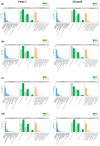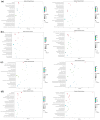Interactions between Brassinosteroids and Strigolactones in Alleviating Salt Stress in Maize
- PMID: 39408841
- PMCID: PMC11477198
- DOI: 10.3390/ijms251910505
Interactions between Brassinosteroids and Strigolactones in Alleviating Salt Stress in Maize
Abstract
Exogenous brassinolide (BR) and strigolactones (SLs) play an important role in alleviating salt stress in maize. We studied the morphological and physiological responses of the salt-sensitive genotype PH4CV and salt-tolerant genotype Zheng58 to BR (1.65 nM), SL (1 µM), and BS (1.65 nM BR + 1 µM SL) under salt stress. Phenotypic analysis showed that salt stress significantly inhibited the growth of maize seedlings and significantly increased the content of Na+ in the roots. Exogenous hormones increased oxidase activity and decreased Na+ content in the roots and mitigated salt stress. Transcriptome analysis showed that the interaction of BR and SL is involved in photosynthesis-antenna proteins, the TCA cycle, and plant hormone signal transduction pathways. This interaction influences the expression of chlorophyll a/b-binding protein and glucose-6-phosphate isomerase 1 chloroplastic, and aconitase genes are affected. Furthermore, the application of exogenous hormones regulates the expression of genes associated with the signaling pathways of cytokinin (CK), gibberellins (GA), auxin (IAA), brassinosteroid (BR), abscisic acid (ABA), and jasmonic acid (JA). Additionally, exogenous hormones inhibit the expression of the AKT2/3 genes, which are responsible for regulating ion transduction and potassium ion influx. Four candidate genes that may regulate the seedling length of maize were screened out through WGCNA. Respective KOG notes concerned inorganic ion transport and metabolism, signal transduction mechanisms, energy production and conversion, and amino acid transport and metabolism. The findings of this study provide a foundation for the proposition that BR and SL can be employed to regulate salt stress alleviation in maize.
Keywords: brassinosteroids; hormone interactions; maize (Zea mays L.); salt stress; strigolactones.
Conflict of interest statement
The authors declare no conflicts of interest.
Figures











Similar articles
-
Mechanisms of Exogenous Brassinosteroids and Abscisic Acid in Regulating Maize Cold Stress Tolerance.Int J Mol Sci. 2025 Apr 2;26(7):3326. doi: 10.3390/ijms26073326. Int J Mol Sci. 2025. PMID: 40244224 Free PMC article.
-
Transcriptomic and Physiological Studies Unveil that Brassinolide Maintains the Balance of Maize's Multiple Metabolisms under Low-Temperature Stress.Int J Mol Sci. 2024 Aug 29;25(17):9396. doi: 10.3390/ijms25179396. Int J Mol Sci. 2024. PMID: 39273343 Free PMC article.
-
Exogenous 24-Epibrassinolide Improves Low-Temperature Tolerance of Maize Seedlings by Influencing Sugar Signaling and Metabolism.Int J Mol Sci. 2025 Jan 11;26(2):585. doi: 10.3390/ijms26020585. Int J Mol Sci. 2025. PMID: 39859301 Free PMC article.
-
The role of strigolactones in resistance to environmental stress in plants.Physiol Plant. 2024 Jul-Aug;176(4):e14419. doi: 10.1111/ppl.14419. Physiol Plant. 2024. PMID: 38973451 Review.
-
Benefits of brassinosteroid crosstalk.Trends Plant Sci. 2012 Oct;17(10):594-605. doi: 10.1016/j.tplants.2012.05.012. Epub 2012 Jun 26. Trends Plant Sci. 2012. PMID: 22738940 Review.
Cited by
-
Mechanisms of Exogenous Brassinosteroids and Abscisic Acid in Regulating Maize Cold Stress Tolerance.Int J Mol Sci. 2025 Apr 2;26(7):3326. doi: 10.3390/ijms26073326. Int J Mol Sci. 2025. PMID: 40244224 Free PMC article.
-
Genome-Wide Identification and Characterization of the BZR Transcription Factor Gene Family in Leymus chinensis.Genes (Basel). 2025 Jan 26;16(2):155. doi: 10.3390/genes16020155. Genes (Basel). 2025. PMID: 40004484 Free PMC article.
-
Regulation of Exogenous Strigolactone on Storage Substance Metabolism and Endogenous Hormone Levels in the Early Germination Stage of Rice Seeds Under Salt Stress.Antioxidants (Basel). 2024 Dec 27;14(1):22. doi: 10.3390/antiox14010022. Antioxidants (Basel). 2024. PMID: 39857356 Free PMC article.
References
MeSH terms
Substances
Grants and funding
- 202401036、202401046、202401035/the College Students' Innovation and Entrepreneurship Training Program of Gansu Agricultural University
- 23ZYQA0322/Central Guide Local Science and Technology Development Fund Project
- 22ZD6NA009/Gansu Province Science and Technology Plan-Major Project
- 2022YFD1201804/National Key Research and Development Project
- 2022CYZC-46/Gansu Province Higher Education Industry Support Plan
LinkOut - more resources
Full Text Sources
Research Materials
Miscellaneous

